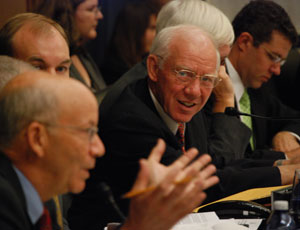An early congressional review of economic-stimulus activity in core infrastructure sectors gives generally good marks for federal and state agencies' progress so far. The House Transportation and Infrastructure Committee on April 29 held the first of a planned series of hearings on the stimulus, the American Recovery and Reinvestment Act. It focused only on programs under the panel's jurisdiction, but they include such key sectors as highways, rail and Environmental Protection Agency water programs.

As of March 31, the committee said, work had started on 263 highway and transit projects, totaling $1.1 billion, in 30 states. An additional 101 projects, valued at $100 million, were under contract, and 1,380 highway and transit projects, worth a combined $6.4 billion, in 47 states were out for bid.
Committee Chairman James Oberstar (D-Minn.) said in a prepared statement, "With a few exceptions, I am very pleased with the progress that has been made in the first 10 weeks since enactment of the Recovery Act, but it is just a beginning."
Oberstar praised U.S. Transportation Secretary Ray LaHood, the first witness, for "the great start" at the department. LaHood said that of the
$48.1 billion the Dept. of Transportation received under the stimulus measure, $44.8 billion has been made available to states and other possible recipients so far and more than $9 billion of that has been obligated for specific projects. "While there is much work remaining, I believe we have already achieved enormous success," LaHood says.
LaHood also shed some light on the stimulus legislation's $1.5 billion in new discretionary grants for major projects. He said DOT has sent a memo to the White House outlining what it sees as "good guidelines for the use of the $1.5 billion." LaHood noted that in the stimulus, Congress provided sizable amounts for highways, transit, high-speed rail and $1 billion for airports, and added that for the $1.5 billion discretionary program, "Our thinking is we should really be looking at ports."
Another topic was high-speed rail, which receives $8 billion in the stimulus. LaHood said DOT plans to convene a meeting of those interested in high-speed rail and ask them "to bring their dreams and plans to Washington"
and discuss them. He noted that California is "way ahead of the curve," with its 2008 bond referendum. But LaHood also suggested that some of the stimulus funds might go to projects that are not among DOT's 11 designated high-speed-rail corridors. All of the high-speed rail lines "aren't on the map," he says.
EPA Administrator Lisa Jackson told the committee that $6 billion of the agency's $7.2 billion in stimulus funds is for Clean Water and Drinking Water State Revolving Funds, and is to be allocated by formulas. She says that about 25% of the $6 billion has been distributed so far. Jackson says that of the remaining $1.2 billion in non-formula funds,"very little of that is on the street right now."
She also said that EPA on April 28 issued new guidance on implementing the stimulus act's Buy American provision. She said that Buy American requirements are new to the SRF program, and noted that many times domestically manufactured pump equipment isn't available. She said the guidance was "a critical step" in allowing states to move forward with the SRF stimulus program.
The panel's top Republican, John Mica of Florida, said he didn't want to be too critical at this early stage of implementing the stimulus. "I think I'm going to give everybody a pass on this one," he said, noting that only a few weeks have elapsed since the measure was signed on Feb. 17. But Mica added, "I think we need to look at who gets the money and...how the money is spent." He did raise raise questions about some of the projects on the stimulus lists, including Ohio's proposal to spend $57 million on planing future transportation projects. LaHood said that U.S. DOT had not yet approved the Ohio proposal.


Post a comment to this article
Report Abusive Comment